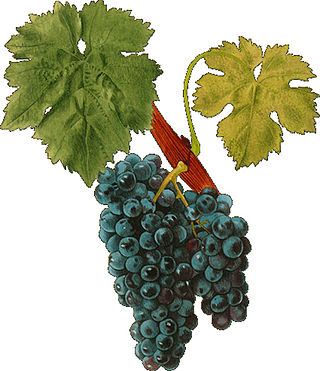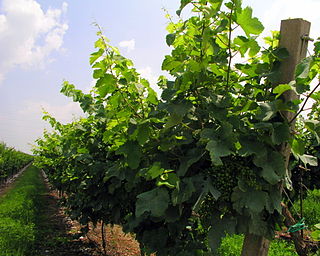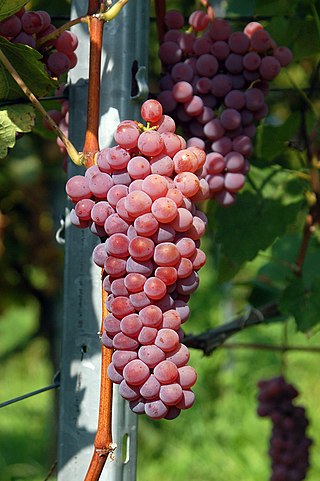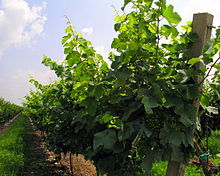
Cabernet Franc is one of the major black grape varieties worldwide. It is principally grown for blending with Cabernet Sauvignon and Merlot in the Bordeaux style, but can also be vinified alone, as in the Loire's Chinon. In addition to being used in blends and produced as a varietal in Canada and the United States, it is sometimes made into ice wine in those regions.

Aurore is a white complex hybrid grape variety produced by Albert Seibel and used for wine production mostly in the United States and Canada. Over a long lifetime Seibel produced many complex hybrid crosses of Vitis vinifera to American grapes. It is a cross of Seibel 788 and Seibel 29.

Carignan is a red grape variety of Spanish origin that is more commonly found in French wine but is widely planted throughout the western Mediterranean and around the globe. Along with Aramon, it was considered one of the main grapes responsible for France's wine lake and was a substantial producer in jug wine production in California's Central Valley but in recent years, it has been reborn as a flagship wine for many cellars in the south of France as well as in Catalonia.

The Muscat family of grapes includes over 200 grape varieties belonging to the Vitis vinifera species that have been used in wine production and as raisin and table grapes around the globe for many centuries. Their colors range from white, to yellow, to pink to near black. Muscat grapes and wines almost always have a pronounced floral aroma. The breadth and number of varieties of Muscat suggest that it is perhaps the oldest domesticated grape variety, and there are theories that most families within the Vitis vinifera grape variety are descended from the Muscat variety.

Dornfelder is a dark-skinned variety of grape of German origin used for red wine. It was created by August Herold (1902–1973) at the grape breeding institute in Weinsberg in the Württemberg region in 1955. Herold crossed the grape varieties Helfensteiner and Heroldrebe, the latter which bears his name, to create Dornfelder. Helfensteiner and Heroldrebe were both crosses created some decades earlier by Herold. Dornfelder received varietal protection and was released for cultivation in 1979. It was named in honor of Immanuel August Ludwig Dornfeld (1796–1869), a senior civil servant who was instrumental in creating the viticultural school in Weinsberg.

Italian wine is produced in every region of Italy. Italy is the world's largest producer of wine, with an area of 702,000 hectares under vineyard cultivation, and contributing a 2013–2017 annual average of 48.3 million hl of wine. In 2018 Italy accounted for 19 per cent of global production, ahead of France and Spain. Italian wine is both exported around the world and popular domestically among Italians, who consume an average of 42 litres per capita, ranking fifth in world wine consumption.

Conegliano is a town and comune of the Veneto region, Italy, in the province of Treviso, about 30 kilometres (19 mi) north by rail from the town of Treviso. The population of the city is of 35,023 people. The remains of a 10th-century castle are situated on a hill that dominates the town. Formerly belonging to the Bishop of Vittorio Veneto, what remains is a bell tower, which now houses a small museum, and outer walls.

Brown Brothers Milawa Vineyard is a family-owned wine company based in Milawa, Victoria, Australia. Brown Brothers was founded in 1889 by John Francis Brown and continues to be owned and operated by his descendants on the original property. Brown Brothers makes wine from a wide range of grape varieties and into a range of styles.
Abouriou is a red French wine grape variety grown primarily in Southwest France and, in small quantities, California. It is a blending grape that, along with Malbec, Cabernet Sauvignon, Syrah, Fer, Cabernet Franc, and Merlot, is used to make the Appellation d'origine contrôlée (AOC) wine of Côtes du Marmandais. Abouriou can also be made into a varietal, as it is used in some vin de pays wines. The grape is known for its low acidity and high tannin content.

Moscato Giallo or Yellow Muscat is a white Italian wine grape variety that is a member of the Muscat family of grapes. Known for its large deep cluster of loose, deep-yellow berries and golden colored wine, Moscato Giallo is grown mostly in northern Italy where it is most often used to produce passito style dessert wines. The grape is also planted in Croatia where it is known as Muškat žuti.

Bronner is a white grape variety used for wine. It was bred in 1975 by Norbert Becker at the viticultural institute in Freiburg, Germany. The variety was initially known under its breeding code FR 250-75, and was later named in honour of Johann Philipp Bronner (1792-1864), who was a German pharmacist and viticultural pioneer. It received varietal protection in 1977.

Merzling is a white grape variety used for wine. It was bred in 1960 by Johannes Zimmermann at the viticultural institute in Freiburg, Germany by crossing Seyve-Villard 5276 with the cross Riesling × Pinot gris.

Cabernet Cortis is a dark-skinned grape variety used for wine. It was bred in 1982 by Norbert Becker at the viticultural institute in Freiburg, Germany as part of a programme searching for disease-resistant grape varieties. It received German varietal protection in 2003.

Glera, also known as Prosecco, is a white variety of grape of Slovenian origin, which was brought to the Italian village of Prosecco from the Karst region. The variety was formerly mostly referred to as Prosecco, but in the EU was renamed "Glera" in 2009 to make room for the protection of "Prosecco" as the name of the Italian geographically-protected wine.

Olmo grapes are wine and table grape varieties produced by University of California, Davis viticulturist Dr. Harold Olmo. Over the course of his nearly 50-year career, Dr. Olmo bred a wide variety of both grapes by means of both crossing varieties from the same species or creating hybrid grapes from cultivars of different Vitis species.
Ravat blanc is a white hybrid grape variety that is a crossing of Chardonnay and a Seibel grape. While the Vitis International Variety Catalogue (VIVC) maintained by the Geilweilerhof Institute for Grape Breeding list Seibel 5474 as the second parent, Master of Wine Jancis Robinson notes that other authors list Seibel 8724 as the parent. The grape is often confused with the white hybrid grape Vignoles that is often called just Ravat.
Cabernet blanc is a white German and Swiss wine grape variety that is a crossing of the French wine grape Cabernet Sauvignon and Regent. The grape was bred by Swiss grape breeder Valentin Blattner in 1991. Cabernet blanc has strong resistance to most grape disease including botrytis bunch rot, downy and powdery mildew and tends to produce loose clusters of small, thick-skinned grape berries which can hang on the vine late into the harvest season to produce dessert wines. Today the grape is found primarily in the Palatinate wine region of Germany with some experimental plantings in Spain and the Netherlands. In France, in the Languedoc, Domaine La Colombette is heavily investing in PIWI grapes. Amongst others the Cabernet Blanc in their cuvée "Au Creux du Nid", is gaining wide acclaim.

Souvignier gris is a white German wine grape variety that was created in 1983 by Dr. Norbert Becker. It is a cross between Seyval blanc and Zähringer, but was originally thought to be a cross between Cabernet Sauvignon and Bronner.
Bianchetta Trevigiana is a white Italian wine grape variety that is grown in the Trentino-Alto Adige/Südtirol and Veneto wine regions of northeast Italy. Here the grape is rarely used a varietal but, instead, is a permitted blending grape adding acidity to the wines of several Denominazione di Origine Controllata (DOC) zones including the sparkling wine Prosecco and has also been used for vermouth production. The name Trevigiana is derived from the province of Treviso where the grape is believed to have originated from.



















